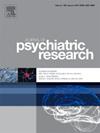Stepwise interventional psychiatry approach for major depression: A case series
IF 3.2
2区 医学
Q1 PSYCHIATRY
引用次数: 0
Abstract
Introduction
Many patients with treatment-resistant depression (TRD) require multiple interventions to achieve symptom relief. We explored outcomes from a stepwise, real-world protocol combining transcranial direct current stimulation (tDCS), repetitive transcranial magnetic stimulation (rTMS), and intravenous ketamine.
Methods
Twenty-eight adults with major depressive disorder were initially treated with a 50-session spaced tDCS protocol. Non-responders were sequentially offered rTMS (30 sessions of iTBS), followed by intravenous racemic ketamine (6 infusions) if needed. Response was defined as ≥50 % reduction in MADRS scores.
Results
Following tDCS, 46.4 % (13/28) of patients achieved response and 32.1 % achieved remission. Of 11 patients who proceeded to rTMS, 36.4 % (4/11) responded. Among the four who received ketamine, 50 % (2/4) responded. The cumulative response and remission rates were 67.9 % and 53.6 %, respectively. Exploratory analyses revealed no significant baseline differences between responders and non-responders.
Conclusions
This case series suggests that a sequential neuromodulation strategy may increase overall response rates in TRD by capturing different responder profiles across modalities. These findings support the feasibility of a pragmatic stepwise approach and highlight the need for controlled studies to guide personalized sequencing strategies.
重度抑郁症的逐步介入精神病学方法:一个病例系列。
导言:许多难治性抑郁症(TRD)患者需要多种干预措施来缓解症状。我们探索了经颅直流电刺激(tDCS)、重复经颅磁刺激(rTMS)和静脉注射氯胺酮的逐步现实方案的结果。方法:28名患有重度抑郁症的成年人最初采用间隔50次的tDCS方案进行治疗。无反应者依次给予rTMS(30次iTBS),然后根据需要静脉注射外消旋氯胺酮(6次输注)。缓解定义为MADRS评分降低≥50%。结果:经tDCS治疗后,46.4%(13/28)患者获得缓解,32.1%患者获得缓解。在接受rTMS治疗的11名患者中,有36.4%(4/11)的患者有反应。在接受氯胺酮治疗的4名患者中,50%(2/4)有反应。累积缓解率和缓解率分别为67.9%和53.6%。探索性分析显示,应答者和无应答者之间没有显著的基线差异。结论:本病例系列表明,顺序神经调节策略可以通过捕获不同模式的不同应答者概况来提高TRD的总体应答率。这些发现支持了一种实用的逐步方法的可行性,并强调了对照研究指导个性化测序策略的必要性。
本文章由计算机程序翻译,如有差异,请以英文原文为准。
求助全文
约1分钟内获得全文
求助全文
来源期刊

Journal of psychiatric research
医学-精神病学
CiteScore
7.30
自引率
2.10%
发文量
622
审稿时长
130 days
期刊介绍:
Founded in 1961 to report on the latest work in psychiatry and cognate disciplines, the Journal of Psychiatric Research is dedicated to innovative and timely studies of four important areas of research:
(1) clinical studies of all disciplines relating to psychiatric illness, as well as normal human behaviour, including biochemical, physiological, genetic, environmental, social, psychological and epidemiological factors;
(2) basic studies pertaining to psychiatry in such fields as neuropsychopharmacology, neuroendocrinology, electrophysiology, genetics, experimental psychology and epidemiology;
(3) the growing application of clinical laboratory techniques in psychiatry, including imagery and spectroscopy of the brain, molecular biology and computer sciences;
 求助内容:
求助内容: 应助结果提醒方式:
应助结果提醒方式:


